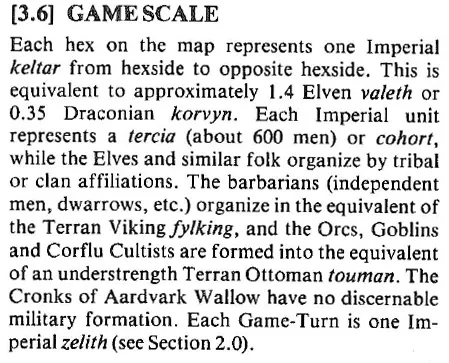SPI’s Swords & Sorcery as a D&D Setting
This post is just Sean McCoy’s Divine Right: Minaria as a D&D Setting but for a different wargame operating on a smaller, more gameable scale.

View the full map in high resolution.
Swords & Sorcery: Quest and Conquest in the Age of Magic is a fantasy wargame released by Simulations Publications, Inc. in 1978. It’s batshit insane: an incredible map covering two thousand 1-mile hexes buried under eighty-six pages of weird lore and unsavory ‘70s nonsense. I’m sure the Army and Quest mechanics are fine, but the presentation is… lacking. Here’s how it communicates the size of its hexes:

[3.6] GAMESCALE Each hex on the map represents one Imperial keltar from hexside to opposite hexside. This is equivalent to approximately 1.4 Elven valeth or 0.35 Draconian korvyn. Each Imperial unit represents a tercia (about 600 men) or cohort, while the Elves and similar folk organize by tribal or clan affiliations. The barbarians (independent men, dwarrows, etc.) organize in the equivalent of the Terran Viking fylking, and the Orcs, Goblins and Corflu Cultists are formed into the equivalent of an understrength Terran Ottoman touman. The Cronks of Aardvark Wallow have no discernable military formation. Each Game-Turn is one Imperial zelith (see Section 2.0).
I blame Gin for sending me down this rabbit hole.
Anyways, there’s plenty of useful stuff to fill out or replace here – castles, towns, keeps, temples, tombs, hell gates, bottomless plungeholes – certainly enough to use for a sandbox campaign if you are willing to use a good hex fill procedure and seed the map with adventure sites.
Using the map
While the game uses 1-mile hexes (thanks to Mr. Mann for confirming this), I am going to scale up to 3- or 6-mile hexes for use with Delving Deeper and other systems.
Additionally, portals and vortex tiles are used in the original game for voluntary teleportation and for spinning up giant storms that can demoralize and destroy units; maybe these become dormant teleportation gates and localized, perpetual storm systems respectively.
The Empire
- Capital city, Urf Durfal
- Glade Keep
- Castle Brandon
- Gateway to the Empire
Aardvark Wallow
- Strakhenville
- The Bottomless Plungehole
- Vortex tile
Ka-Chunk
- Capital, Temple of the Corflu Cultists
- Hill of Avalon
- The Tombs of the Damned
- Vortex tile
- Portal #6
Capella
- Portal #5
Minotaurus
- Stream of Consciousness
- Toll Troll
- Vortex tile
- Vortex tile
- Vortex tile
The Swamps
- The Ruins
- Stream of Reflection
- River ford
N’Dardia
- Toll Troll
Rhiannon
- Vortex tile
- Vortex tile
Endore
- Castle Gund
- Toll Troll
Nattily Woods
- Capital city, unnamed
- Portal #3
- Vortex tile
Vynar
- Capital, unnamed
- Vortex tile
Neitherwold
- Empty
Krasnia
- Capital village, Balkathos
- Battleaxe Stronghold
Outer Krasnia
- Empty
Dwarfhaven
- Empty
Kanathar
- Empty
Zirkast
- Capital village, Nuara
- The Iron Fortress
- Toll Troll
- Vortex tile
EvAlyn Woods
- Fountain of Health
- Portal #4
- Vortex tile
Ithilgil
- Capital village, New Orc City
- Castle Krawn
Intas
- Capital city, Citadel of Blood
- Gateway of Evil
- Portal #2
- Vortex tile
- Vortex tile
- Vortex tile
- Vortex tile
Kelgarnth
- Capital, unnamed
- Mount Greymoor
Graumthog
- Citadel of Ice
- Stream of Tears
- Portal #1
- Vortex tile
Convivia
- Capital village, Rykalla
- Castle Dalarna
- Gerlod
- The Convivial Mountains
Sorcerak
- Capital, unnamed
- Altar of the Elder Gods